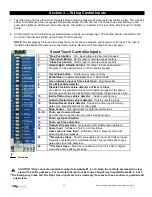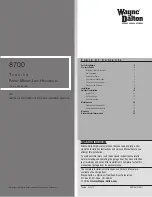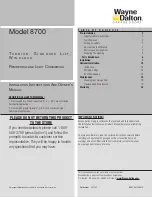
35
© 2012 Installation and Reference Manual D0125 Rev. H
Section 4
—Installing Gate Edge (Contact Type) Reversing Sensor, cont.
1. Follow the guidelines in the Entrapment Protection Device illustration to plan the most appropriate mounting positions
for the edge sensors to be installed. For sliding gates, one or more sensors shall be located at the leading edge,
trailing edge and post mounted both inside and outside of a sliding gate. A requirement of the UL 325 standard is that
an edge sensor be laboratory tested and “recognized” under UL 325.
2. Drill holes through the edge’s mounting channel and through the surface that each gate edge is to be mounted.
Securely fasten every edge sensor. The edge sensors should all be placed not higher than 6” above the ground.
3. Edge sensors that are not attached to the moving gate, such as post mounted sensors are wired in parallel and
directly connected to the gate operator:
a. Mount a gate edge to the wall, pilaster or end post of the fence that aligns with the gate when it is in the open
position.
b. Always route the leads of the edge sensors to the gate operator so that they are protected from physical damage.
c. Connect one edge sensor lead to our Common Buss on the power supply board and the other to terminal #13,
which is labeled
Edge Sensor
input.
4. Edge sensors mounted to the leading edge or trailing edge of the gate panel should be used with an edge transmitter
and a receiver in order to transmit to the gate operator. We do not recommend the use of retractable cord reels or
curl cords because of durability problems with these devices in outdoor environments.
a. Mount gate edge sensors to the leading edge and trailing edge of the gate so that entrapment protection is
provided in both directions of travel.
b. Mount one or two edge transmitters (Linear Model #3022
or equivalent) onto the gate panel near the upper corner
of the leading edge of the gate. Both gate edges will function correctly if only one transmitter is used, but wiring
both edges to a single transmitter may be impractical or displeasing visually.
c. Connect the edge(s) to the terminals in the edge transmitter and set the “DIP” switches of the transmitter to match
the setting in the receiver to be used.
5. Mount a commercial style radio receiver
*
(external antenna type) on the inside of the operator, below the electrical
box. Knock out the smallest hole in the lower right corner of the electrical box and route the wires to the area marked
Radio Options. Only three wire connections are needed because the 24-Volt supply and the radio output share a wire.
Being certain to observe polarity, crimp the black radio power wire together with one of the radio output wires into a
.25” spade connector and connect to the COM terminal. Connect the red wire to the +24V terminal and connect the
other radio output contact wire to the spade marked EDGE. Note that this terminal is the same as the #13 input
terminal labeled Edge Sensor on the main control board.
a. Mount an external antenna onto the top of a fixed post of the fence near the operator.
b. Connect the antenna into the socket on the radio receiver.
c. Set the “DIP” switches in the receiver to match the same code used in the transmitter.
6. Test the operation of the reversing edge to make sure that it is functions correctly. Advise the user of the gate to be
certain to retest this vital function weekly.
*
If there is also to be a radio receiver for a hand held transmitter to operate the gate, be certain to use a two channel
commercial receiver. The edge and hand held transmitters must have their codes set the same or they will not
function.
Summary of Contents for SlideDriver 50VF2
Page 2: ......
Page 28: ...14 2012 Installation and Reference Manual D0125 Rev H Section 2 Technical Drawings...
Page 29: ...15 2012 Installation and Reference Manual D0125 Rev H Section 2 Technical Drawings...
Page 36: ...22 2012 Installation and Reference Manual D0125 Rev H Section 3 Wiring Control Inputs...
Page 63: ...49 2012 Installation and Reference Manual D0125 Rev H Section 6 Internal Solenoid Lock Drawing...
Page 64: ...50 2012 Installation and Reference Manual D0125 Rev H Section 6 Internal Solenoid Lock Drawing...
Page 81: ...68 2012 Installation and Reference Manual D0125 Rev H...
















































